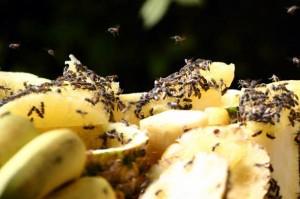
Summer is here and for winemakers that means one thing: the inevitable return of our sworn enemy, Drosophila melanogaster, the common fruit fly. Minute little flying monkeys of doom, they’re hard to exclude from your winemaking areas, and while they’re easy to kill, by the time you’ve swatted one thirteen more have materialised out of thin air, looking for a free meal—females lay 400 eggs each, and they mature in as little as 7 days!
The reason why we need to be concerned over the little monsters isn’t just that they’re unsightly and chewy when you discover one inside a mouthful of Chardonnay. No, it’s their other name we need to think of, ‘Vinegar Fly’. The little blighters are filthy with acetobacteria, the organism that turns our delicious alcohol in to vinegar.

How to combat ‘em? First, understand that they don’t eat fruit: they eat mainly yeast. When they smell carbon dioxide and alcohol, they think it’s a piece of rotting fruit where they can lay eggs and get a delicious meal. When they smell a fermenting carboy, it’s their equivalent of a Vegas buffet ten thousand miles long.
Anybody who has ever worked as a bartender over the summer months knows the sad and icky truth: you come in for the first shift of the day and any bottles that have been left with an open pour-spout (‘speed spout’) overnight will need to be poured through a coffee filter to extract the little winged corpses from their watery graves. If a fermenting carboy smells a buffet, and bottle of vodka smells like ten tons of chocolate cake.
Step one in managing these horrific little pests is exclusion. You can’t keep them out of your house and your fermenting area, so you’ll need to exclude them from the wine itself. Always do covered fermentations. The commonest fermentation vessel used to start kit wines in the US is a 7.9 gallon (30 litre) bucket with a tight fitting lid and a port to plug in an airlock. By keeping the wine sealed and airlocked, you’ll deny entry.
Second, when your wine goes to the carboy, make sure you keep that airlock topped up with water. Some folks use sulphite, and while that’s mostly harmless the sulphite usually oxidises off in a few days into plain water. Other folks want the sanitising power of alcohol and load the airlock up with Everclear or grain alcohol—this only attracts the enemy!
Third, you’ll need to wipe up every single little tiny spill of wine or juice immediately, and sulphite the area to prevent any residue from getting a yeast film going on it. Then make sure you wash your cloths or discard your paper towels in a tightly sealed receptacle—the cloth used to wipe up the juice will become a source of attraction.
Fourth, if you have to wash all racked primary fermenters or carboys (those with lees and even a small amount of cloudy wine in them) immediately. If you can’t get to the right away, pop the bung and airlock on again.
Fifth, if you filter your wine (always a good idea—I’ll talk about that in a later blog) break down and clean your filter right away, and seal the used pads in a plastic bag before discarding them: they smell just dandy to fruit flies.
Flypaper only works on fruit flies by accident. Plus, some of the stuff is toxic as all get-out, and not good for winemaking areas. You can set up a wasp trap (available from hardware stores) for them. Normally they’re filled with fruit juice or other sweet liquid, but that doesn’t impress a fruit fly. Fill it with the magic formula: apple cider vinegar with a couple of drops of liquid dish soap. The apple cider vinegar drives them to a gustatory frenzy, while the dish soap removes the surface tension of the liquid: when they fly in and hit it, they drown right away—poof!
You can also, check out natural pyrethrin-based insecticides: they’re made from plant oils, are mostly safe and can be used in food prep areas. Never use any other kind of insecticide around wine or food prep areas! Triple-check to make sure you’ve got pyrethrin and not the synthetic pyrethroid, which is much more persistent and killier. Pyrethroids are bad for the environment and can be toxic to children and pets, especially kitty-cats, who lack the enzyme to break them down, and can rapidly succumb to pyrethroid toxicity. No kitty should be collateral damage to a fruit fly!
It should be noted that cleanly made wines that have fully fermented and are sulphited to an appropriate level (follow the manufacturer’s instructions) are fairly resistan against colonisation by acetobacteria. Sulphite in particular is a good bacterial inhibitor for this organism.
But there’s always that chance: a missed sulphite addition, a little extra oxygen pick-up in fermentation, one lone fruit fly wings in and . . . well, that’s thirty bottles of wine you can’t even pour on your salad (wild acetobacter fermentations make a kind of vinegar that tastes mostly like nail-polish remover).

I just came back here to look up the fruit fly trap recipe because it has suddenly become extremely relevant to my life.
Thanks!
My pleasure: it’s fly season at Chaos Manor as well and unattended glasses of wine are under seige. Darn drosophilia-
Tim
Well wouldn’t ya know it, someone left an unrinsed, wine soaked rag in the bucket overnight!!! Those little buggers are worse than rabbits!!! Well, I left about 5 wine glasses with your recipe in them and by golly, the next day there was about 10 or so in each one. Now that the rag bucket is empty, we seem to be under control again but the wine glasses will remain until November! Thank again Tim. Your suggestions and remedy’s are always welcome here in the wine shop